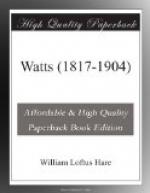One of the striking incidents in the life of Watts was his offer to decorate Euston Railway Station with frescoes entitled “The Progress of Cosmos.” “Chaos” we have in the Tate Gallery, full of suggestiveness and interest. We see a deep blue sky above the distant mountains, gloriously calm and everlasting; in the middle distance to the left is a nebulous haze of light, while in the foreground the rocks are bursting open and the flames rush through. Figures of men, possessed by the energy and agony of creation, are seen wrestling with the elements of fire and earth. One of these figures, having done his work, floats away from the glow of the fire across the transparent water, while others of his creative family have quite passed the struggling stage of movement and are reclining permanent and gigantic to the right of the picture. The same idea is repeated in the chain of draped women who are emerging from the watery deep; at first they are swept along in isolation, then they fly in closer company, next they dance and finally walk in orderly procession. But Chaos, for all this, is a unity; of all material forms it is the most ancient form; Cosmos however is the long-drawn tale beginning with the day when “The Spirit of God brooded on the face of the waters.” Cosmos might have been Watts’ synthetic pictorial philosophy; Herbert Spencer with his pen, and he with his brush, as it were, should labour side by side. But this was not to be; the Directors of the North-Western Railway declined the artist’s generous offer, and he had to get his “Cosmos” painted by degrees. On the whole, perhaps, we should be thankful that the railway company liberated Watts from this self-imposed task. We remember that Dante in his exile set out to write “Il Convivio,” a Banquet of so many courses that one might tremble at the prospect of sitting down to it; the four treatises we have are interesting, though dry as dust; but if Dante had finished his Banquet, he might never have had time for his “Divine Comedy”; so perhaps, after all, we shall be well content to be without Watts’ “Cosmos,” remembering what we have gained thereby. Besides, the continuous and spontaneous self-revelation of an artist or a poet is sometimes truer than a rigid predetermined plan.
[Illustration: Plate IV.—Thomas Carlyle
(At the South Kensington Museum)
This canvas was painted in 1868, and is the earlier of the two portraits of the famous historian painted by Watts. It formed part of the Foster Bequest. It is interesting to compare this with the painting in the National Portrait Gallery.]
A few words from the pen of the artist, appearing by way of preface to a book, “A Plain Handicraft,” may here be quoted to indicate the strong views Watts took on the “Condition-of-England Question.” His interest in art was not centred in painting, or sculpture, or himself, or his fellow artists. He believed in the sacred mission of art as applied




